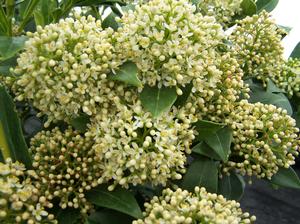View All Plants :: View All BROADLEAF EVERGREEN SHRUBS
Skimmia japonica FEMALE
Skimmia
Plant Type:
BROADLEAF EVERGREEN SHRUBSSkimmia japonica FEMALE (ex: Jonathan Lehrer, Environmentals) - This is a typical female growing 3 to 4 feet high and wide. Flowers, foliage and fruit are typically handsome... or should I say beautiful? That seems more anthropomorphically gender appropriate! This female plant requires a male for fruit production. The species is from Japan. Spring planting advised in the north. Cutting grown.
Height:
36-48 inSpread:
36-48 inColors:
WhiteCharacteristics and Attributes for Skimmia japonica FEMALE
Season of Interest (Flowering)
- Spring
Season of Interest (Foliage)
- Four Seasons
Autumn Interest
- Fruit / Berries / Seed Heads
- Showy Buds
Light
- Shade
- Dappled Shade
Attributes
- Evergreen
- Fragrant
- Woodland
- Foundation
- Ground Cover
- Shrub Border
Growth Rate in the Garden
- Medium
Soil
- Fertile
- Organic
- Acid
Origins
- Japan
Propagated By
- Cutting Grown
Genus Overview: Skimmia
Common Name: Japanese Skimmia
These broadleaf evergreens with simple, alternate leaves cast a medium to medium dark green color. They slowly sucker and in time will form ground covering colonies that are simply beautiful. Clustered showy buds are red to maroon; inflorescences are rounded domes. Though flowers are small, the gestalt of the entire collection of tightly packed florets on the individual flowering structures is showy. Flowers are usually white, larger and a bit more fragrant on males.
Skimmia is dioecious; as with hollies males and females must be present for fruit production (except for S. reevesiana whose flowers are bisexual.) Females form beautiful semi-glossy red fruit which ripens in autumn persisting until the following spring. Each fruit is approximately 1/3 inch diameter. There is also a striking white berrying form, 'Wakehurst White'. Please note that the fruit is poisonous.
USDA climate zone 7 is the northern end of their cold hardiness range. We in northeastern Connecticut are slightly north of Skimmia's Mason-Dixon line. However, I have a customer in Voluntown - not far from us in Brooklyn - who claims she's getting them through just fine in a sheltered spot. However, she may be growing Skimmia reevesiana which is said to harbor greater hardiness than S. japonica.
Culture is easy. All are content in dappled or open shade, an east exposure with morning sun is acceptable. Organic, fertile soils on the acid side of the Ph scale which retain moisture between rains are required for best performance. And I would venture to say that at the northern end of their range protection from searing winter winds is cautioned - this is a general rule of thumb for all broadleaf evergreens. All the following are cutting grown.
Some of our offering we believe to be honest to goodness named cultivars. But any with the least bit of uncertainty will be discussed so that you will be informed. Beyond our selection it is unfortunate that Skimmia identification in the larger botanic world is an entangled mess.
